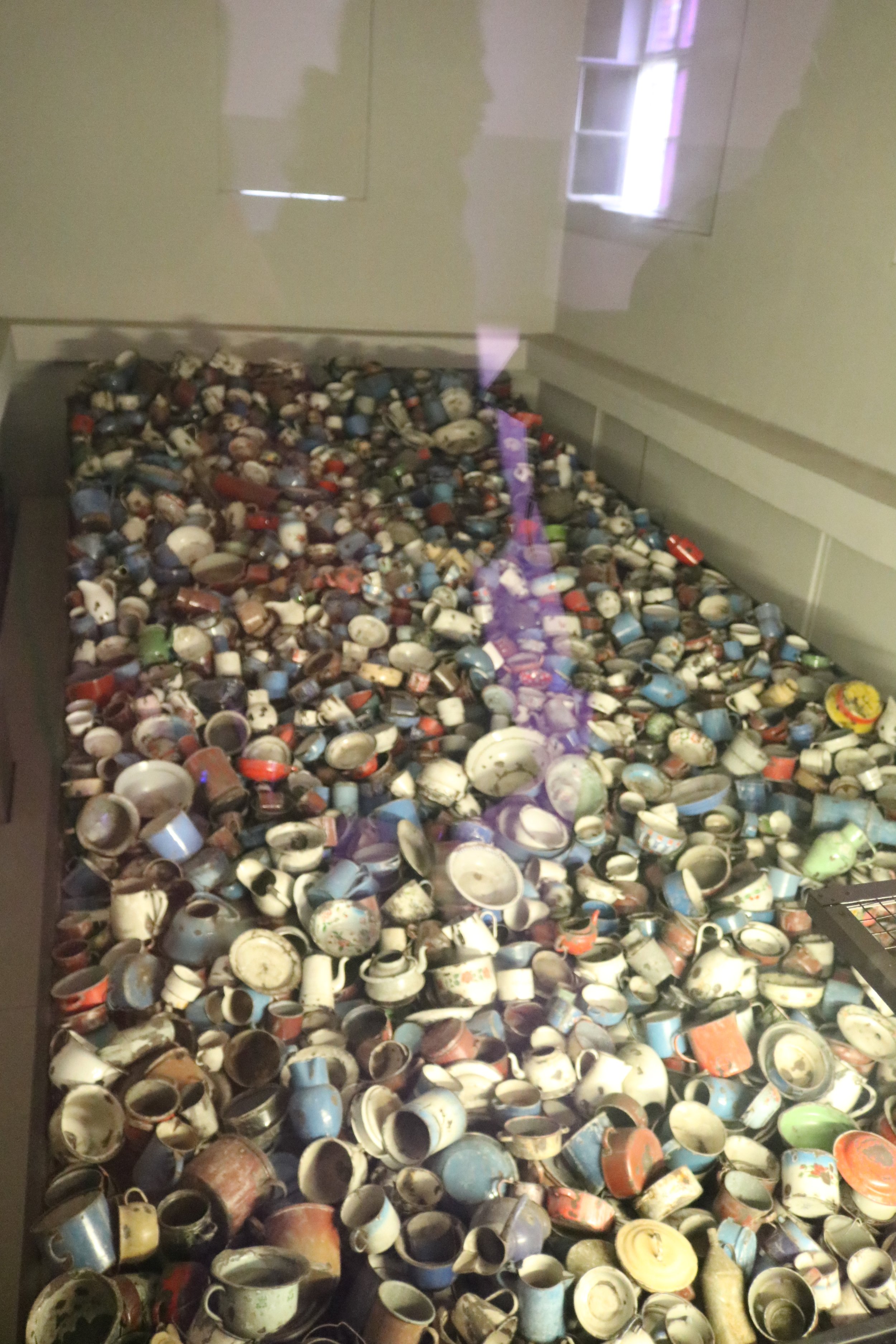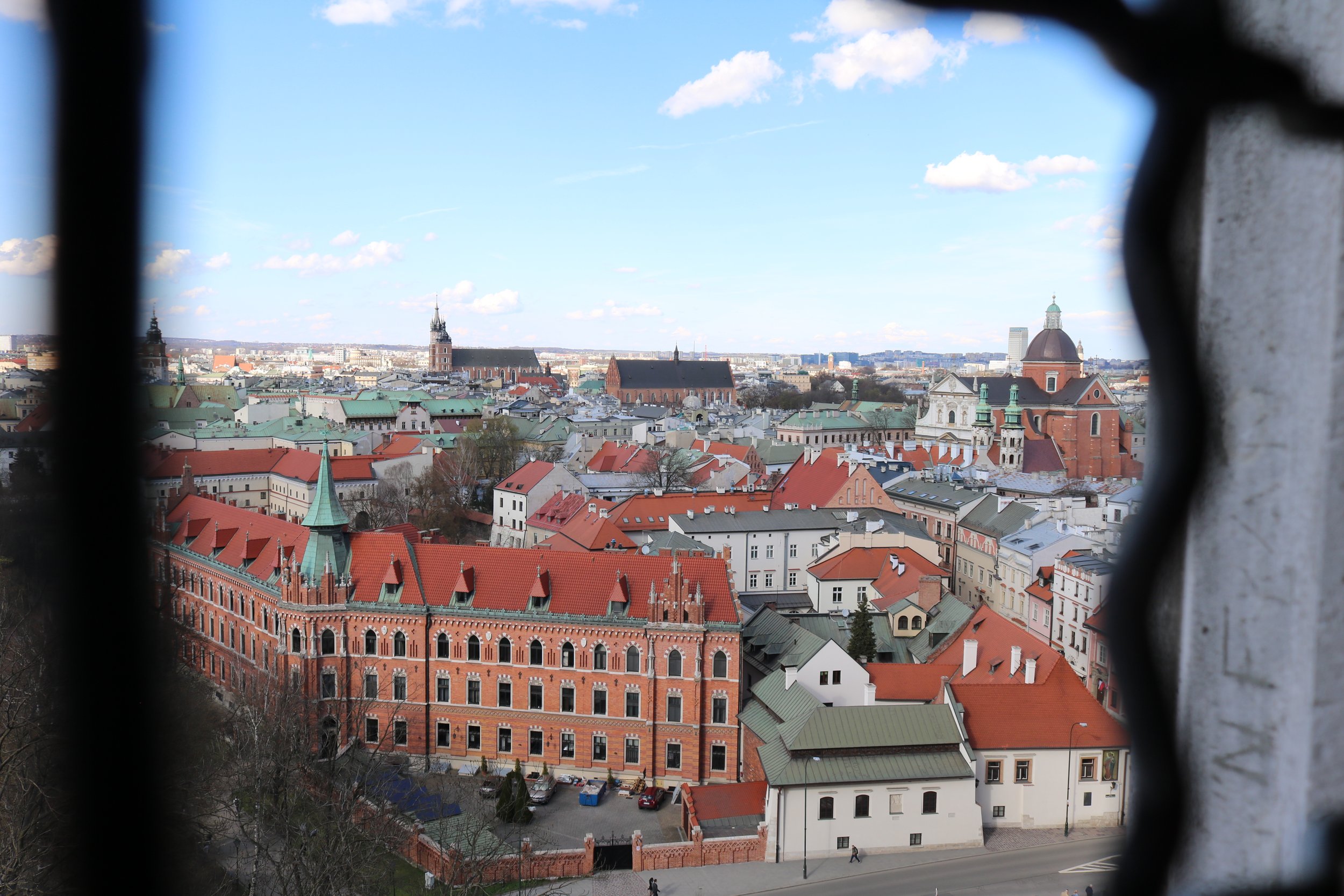Day 2 - Auschwitz-Birkenau
The day started alarmingly early at 6:30 am. I had a tour booked which was meeting at 8 am, and the meeting point was a 30-minute walk from my hotel. So I was the first person at breakfast - in fact, I was eating with the cleaning staff. I also did a Bryan/Read thing of making myself a sandwich for lunch - I promise I was advised by my tour guide to do this, as there isn’t time to buy food on the tour.
I walked through the old town, the main square, to quite a main road which was really busy with everyone off to work. I met my guide (actually she is the driver) and four other people and we set off for the hour and 15 minute drive to Auschwitz-Birkenau concentration camp.
I have been very interested in the history of the holocaust since my mother-in-law bought me The Diary of Anne Frank (The Diary of a Young Girl). It was the first book she ever bought me and I was hooked. We have visited the museum in Amsterdam on a few occasions. Auschwitz had been something I felt I ‘should’ do. I say ‘should’ as lots of people have asked me why on earth I wanted to visit, and I can’t explain entirely, but I do feel that I personally needed to be better educated. I wouldn’t blame anyone for not wanting to see it (my husband included). It is visited by over 2 million people a year and was actually preserved and opened as a museum along with the wishes of those that survived/were liberated.
When we arrived we were assigned a guide who was a lovely woman (sorry, I can’t remember her name - I could make one up if it helps?) and she started our tour of Auschwitz I. I knew this was going to be tough, but with her first sentence, I felt a terrible weight in my chest. We were taken to the main gate, where the sign (not the original) says ‘Arbeit Macht Frei’ - a German phrase that translates to ‘Work Sets You Free’. We all had headsets on, so that we could hear our guide easily, and also so that she could talk quietly.
Auschwitz started its life as a military base. It was turned into a prison by the Germans, due to the mass arrest of Poles (anti-Nazi, politicians, and resistance members). It was designed to be a concentration camp, but it also became an extermination camp so that the Nazis could murder all European Jews (a policy known as the ‘Final Solution’). It’s position in the centre of Europe made it particularly appealing to Hitler.
Auschwitz I is the first and oldest camp, - and the number of prisoners was around 20,000 at a time. It was established on the grounds and in the buildings of prewar Polish barracks. The local area’s population, the Poles and Jews living near the camp, were evicted from them in 1940-1941 to make way for the camp’s enlargement. Around 1,000 of their homes were demolished. Other, more grand buildings were assigned to officers who came here with their whole families.
The Polish Jews that were living in the ghettos in Krakow were taken by train (which were actually cattle trucks) and were told that their lives would now be better. They packed all of their possessions and arrived in Auschwitz. They would disembark and told to leave their belongings on the platform, with the promise they would be returned to them after ‘disinfection’. A team of nazi doctors would make the selection of which line you were in - left or right. One line would be deemed ‘fit for work’ and the other line, which would be mainly young children, pregnant women, and the elderly or disabled would be in the other line. That line would be sent to the bathhouses where they stripped naked and went into the showers. Actually, those showers (even fitted with mock shower heads) were gas chambers. Once inside they were exposed to Zyklon-B gas and would die within 20 minutes. They were never officially registered, so the number that were murdered is still unknown. They then had their hair removed, along with gold teeth and jewellery and were cremated. At the height of deportations (1943-44), an average of 6,000 Jews were gassed each day.
One photo showed them all leaving the train with so much stuff - they clearly did think that they were starting a new life. So utterly sad.
Those chosen fit for work would be given a blue and white striped uniform and helped run the camp, or were sent to do manual labour in the surrounding areas. They were sent to work in a local factory, making items for the war effort.
We moved through a number of the buildings where the workers would live - sleeping on either straw or mattresses made of straw.
The women’s quarters - six to a bunk
The hair from each of the victims was bagged up and sent to Germany to make ropes. A lot of hair was found after the camp was liberated and is now in a display case. There was much of it - all piled up in the case, a mass of brown. Apart from a few blonde plaits - I assume from children.
There were piles of shoes, piles of glasses, and piles of pots and pans. I didn’t take many photos - it just felt wrong. It was so overwhelming. Our guide kept listing lots of numbers, numbers of those that were executed, how many slept in a bed, and how little food they were given - each statistic more shocking than the last. I couldn’t hold back the tears any longer, and they started to roll down my face.
Pots, pans, cups, plates
One of the blocks, block 10, was used to experiment on women. One particular doctor the infamous, Josef Mengele (the ‘Angel of Death’) performed horrific experiments on women, twins, those with dwarfism, and those with certain eye colours. I won’t go into this here, but you can read up on this if you would like.
Many of the prisoners died from starvation or poor sanitation. Some, after being imprisoned in tiny cells for breaking rules, were lined up against a wall and shot in the back of the head.
To make things even more awful, many of the prisoners were ordered to work in the crematoriums. At this point, I wasn’t sure that being spared the initial extermination was a better option.
We had a small break and were then taken for the short ride to the Birkenau camp (which held over 90,000 prisoners in 1944). This camp is known as "Auschwitz II".
This was the largest part of the Auschwitz complex. It was huge. The Nazis began building it in 1941 on the site of the village of Birkenau. The Polish civilian population was evicted and their houses confiscated and demolished. The greater part of the apparatus of mass extermination was built in Birkenau and the majority of the victims were murdered here.
The Germans isolated all the camps and sub-camps from the outside world and surrounded them with barbed wire fencing. All contact with the outside world was forbidden. However, the area administered by the commandant and patrolled by the SS camp garrison went beyond the grounds enclosed by barbed wire. It included an additional area of approximately 40 square kilometres (the so-called "Interessengebiet" - the interest zone), which lay around the Auschwitz I and Auschwitz II-Birkenau camps.
At the end of 1944, the defeat of Nazi Germany looked increasingly likely, so the Germans started to destroy Auschwitz and the records held there. In January 1945, the Germans marched 60,000 prisoners to a Polish town 30 miles away, for onward transportation. These marches became known as the death marches, since many died en route, due to cold and malnourishment, or were shot in the head for not being able to keep up. Those completing the march were sent on trains to concentration camps in Germany.
When the Soviet army entered Auschwitz, they found 7,600 prisoners left behind, who were then nursed back to some form of health.
Auschwitz is the largest mass murder site in history. Between 1940-1945, 1.3 million people were deported to the camp:
1,100,000 Jews
140,000-150,000 Poles
23,000 Roma/Gypsies
15,000 Soviet POWs
25,000 prisoners from other ethnic groups
1,100,000 of them died in Auschwitz, 90% of them Jews, with the majority murdered in the gas chambers.
We left the camps and drove back to Krakow - silence in the minibus as we all sat with our thoughts.
The weather had really improved and the sun was shining high in the sky. I could have easily gone back to bed, but the forecast isn’t great for the rest of the week, so I decided to get out and explore.
I walked back to the square (my main navigation point) and headed to Wawel Royal Castle. The Castle is set on a hill next to the main river (Vistula). It used to be the home of the Kings and Queens. A bit of research before I came told me that many of the staterooms are closed for refurbishment, which I wasn’t too sad about, so I just walked UP that huge hill and walked around the grounds.
I saw a small ticket office and wandered in, seeing what I might be buying, and it was a ticket to the cathedral. According to my guidebook, it is the single most important building in Poland (owing to the raft of coronations held there). It was ok. Sorry - I know I should be wowed by all the gold in there, but having just been to Auschwitz it all felt a bit too much of a contrast.
The castle on the hill
I did, however, walk up lots of tiny wooden ladders to reach The Royal Sigismund Bell. It’s a big ol’ bell! I was afforded some amazing views from the bell tower.
View from the big bell bit
I climbed down another set of ladders and walked the banks of the Vistula river for a while. Lots of people enjoying the sunshine, cycling, running, walking. It really is the most beautiful city. By now, I was really very weary, so I went back to the hotel, had a lovely hot shower, talked to Andrew and Oli, and then went out for dinner.
The thing about being alone and dining out, is that you can very easily spend ages looking at menus in windows and not deciding on anything. You just have to be brave and go in one. So I checked one menu which had lots of lovely pizzas on it, and looked nice. I went in and saw it was full of men watching a football match! Oh well, I was in then. I ordered a mushroom and onion pizza and a small beer. It was delicious. Nobody cared about the middle aged woman reading her book.
Off to bed now. A little bit wiser and a little bit sadder. Sweet dreams - I will leave you with the words of none other than Mr Steven Spielberg.













